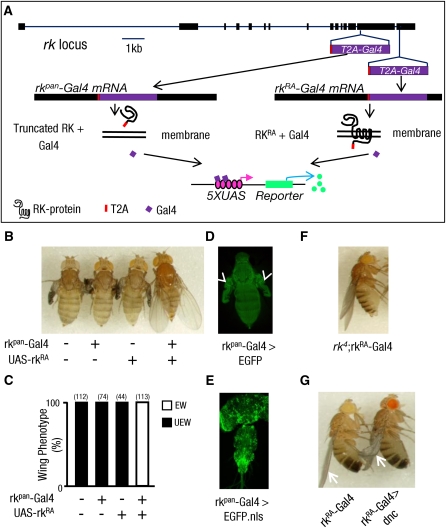Figure 3 .
In-frame fusions of T2A-Gal4 can couple Gal4 expression to that of an endogenous gene. (A) Schematic of the intron–exon structure of the rickets gene locus. The in-frame insertion sites of the T2A-Gal4 sequence are indicated. Two insertions were made in the rk sequence of the genomic P[acman] clone CH322-119A8 (see Figure S2), one within exon 14, which is common to all rk transcripts, and one just prior to the stop codon of the rk-RA transcript located in exon 15. Transgenic flies bearing the first of these constructs, rkpan-Gal4, produce a truncated, presumably secreted RK protein without transmembrane domains, while flies bearing the second construct produce a full-length RK protein with a C-terminal T2A peptide fusion. (B) Pictures of rk4 mutant flies (−/−) carrying either the rkpan-Gal4 transgene, a UAS-rkRA rescue transgene, or both. The wing-expansion deficits of rk4 mutants were rescued only when the UAS-rkRA expression was driven by rkpan-Gal4. (C) Bar graph summarizing the frequency of flies of the various genotypes with unexpanded wings (UEW) vs. expanded wings (EW). Total numbers of flies scored is in parentheses above each bar. (D) Fluorescence image of epidermal UAS-EGFP expression driven by rkpan-Gal4 in a newly eclosed fly. Arrowheads indicate prominent labeling of the wing epidermis prior to expansion. (E) Confocal micrograph of UAS-EGFP.nls labeling in the central nervous system driven by rkpan-Gal4 in the pharate adult. (F) Wing-expansion phenotype of an rk4 mutant fly expressing the rkRA-Gal4 transgene. Rescue of the wing-expansion deficits shows that the RK protein produced by the rkRA-Gal4 construct is functional. (G) A representative fly (right) in which the rkRA-Gal4 transgene drives expression of the dunce gene, which encodes a cAMP-phosphodiesterase, to disrupt the second messenger pathway activated by RK protein. Wings (arrows) in such flies remained incompletely expanded, compared with flies not expressing UAS-dunce (left), indicating that cells within the rkRA-Gal4 expression pattern contribute to wing expansion.

